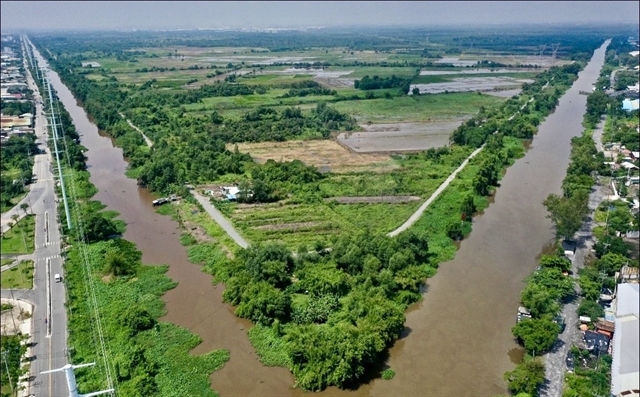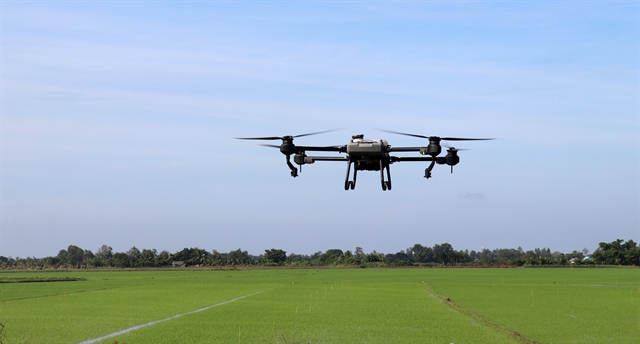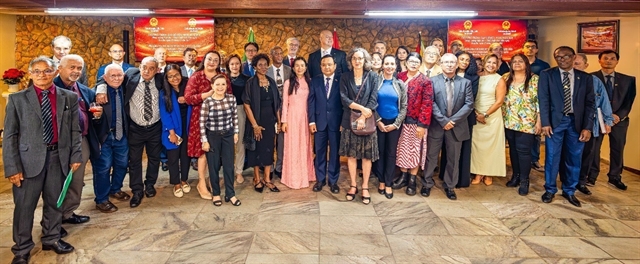 Society
Society

 |
| A drone is used to spray pesticides in rice fields in Kiên Giang Province’s Châu Thành District. — VNA/VNS Photo Lê Huy Hải |
KIÊN GIANG — The Cửu Long (Mekong) Delta province of Kiên Giang has restructured its rice farming well to achieve better production efficiency.
The country’s largest rice growing province has increased the cultivation of high-quality varieties, adopted advanced techniques and mechanisation, and developed linkages between stakeholders in production and consumption.
Its farmers grow around 720,000ha of rice with an average output of 4.4 million tonnes a year.
The province Department of Agriculture and Rural Development has instructed farmers to grow high-quality varieties that are suitable for local conditions.
Lê Hữu Toàn, deputy director of the department, said the cultivation of high-quality varieties would enable focus on quality rather than quantity, increase product value and farmers’ incomes, and thus foster sustainable development of agriculture.
Hòn Đất District, which has the largest rice growing area in the province, has increased farming of high-quality varieties.
Dương Minh Tâm, deputy secretary of the Hòn Đất Party Committee and chairman of its People’s Committee, said high-quality varieties account for 98 per cent of the district’s rice growing areas, up from less than 74 per cent in 2015.
The district has zoned 26,000ha for them to the north of National Highway No.80, he said.
The province Agriculture Forestry and Fisheries Seed Centre has created many new rice varieties such as GKG1, 5, 9, and 35.
They have short gestation periods, are well adapted to climate change, resistant to saltwater and disease, have high yields, and meet the requirements of export markets.
The province has instructed farmers in techniques like reduced sowing and use of certified seeds to increase yield and quality, growing rice to clean standards and linking up with companies to secure outlets.
The Thuận Phát Shrimp Crab Rice Services Co-Operative in An Minh District’s Đông Hưng Commune grows organic rice since its establishment in 2017 and has linked up with companies to sell its output.
Lê Thế Sua, its chairman, said the co-operative grows 100ha of organic rice under contracts and sells the produce at VNĐ10,000 (42 US cents) a kilogramme.
Conversion
Kiên Giang has also converted unproductive paddies to grow other high-value crops and adapt to climate change.
On more than 4,480ha, farmers now rotate between rice and other short-term crops or have switched completely to other crops, according to its Department of Agriculture and Rural Development.
To rotate they opt for vegetables or aquatic species, and these offer them 2.5-4 times higher incomes than rice, it said.
Farmers who breed aquatic species in rice fields earn VNĐ85 million ($3,600) per hectare annually.
The cultivation of three rice crops a year makes lands unfertile and reduces yields, and the rotation also helps reduce rice diseases.
In Giang Thành District, many rice farmers have switched to growing lotus in their fields in low-lying areas which are often inundated during the rainy season.
Trần Văn Thuỷ in Giang Thành’s Phú Lợi Commune harvests around six tonnes of lotus pods per hectare annually.
The pods fetch an average price of VNĐ15,000 (63 US cents) a kilogramme, he said.
“Growing lotus requires hard work but it fetches three to four times the income rice does.”
Farmers in the district also rotate rice with corn, sesame, soy bean, water melon, or sweet potato.
Besides short-term crops, many rice farmers have switched completely to perennial ones such as orange, mandarin, mango, and other fruits.
The area under fruits increased to 23,721ha by 2020 from just 2,883ha in 2015 as more rice farmers made the switch, according to the province People’s Committee. — VNS




